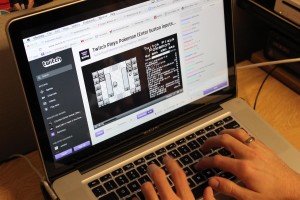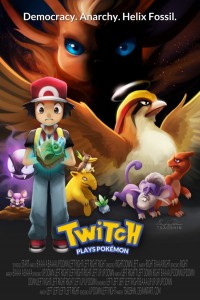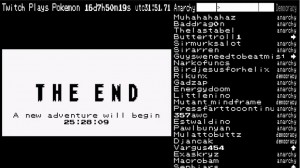In 1996, the original game “Pokemon Red” and its counterparts released in North America, changing the gaming culture forever. As it has grown throughout the years into more colorful, story-enriched games, nobody could have predicted how far the gaming experience could go.
Enter: Twitch Plays Pokemon.
Video games, from the time of arcade joysticks, Pong, and Atari, was invented and played by only a single to a few players at most. But because of the massive people-connecting technology called the internet, it is more than possible for thousands of people to simultaneously play a single game in real-time. This evolution expands video games into so many more possibilities of gameplay mechanics than ever before imagined.
What started out as a simple notion turns into something beautifully chaotic. On the gaming live stream website Twitch, the original intent is to stream games as a single person plays them, and for people to watch and converse in the associated chat application. An anonymous Australian programmer coded the game Pokemon Red so that with this stream, the chat can control the game character. Input commands are the same as its original console, the Game Boy. To go up, type in “up”. To select something, type “a”. For the start menu, type in “start”, etc.
This began as a simple social experiment to see if crowdsourcing could be used to play, and ultimately beat, a game. At first, only a few hundred people were participating, but through word of mouth (and the internet of course) the amount of people watching the stream at one time grew to more than 180,000 people in its peak time, with more than 20,000 people actively participating.

These numbers were higher than anybody could have predicted. More than hundreds of inputs were given per second, and it became difficult to move our character ‘Red’ anywhere.
After a few days, the original programmer knew something had to be done to help the people playing progress. A system of Anarchy and Democracy was implemented, with each having its own way of using commands given to the game. In Anarchy mode, the commands are received in the same way it was, with every command being used in the order they arrive. Democracy mode uses a voting system. Only the most common commands are used, which can make progress much easier if most people know what to do. The mode changes enough people enter in ‘anarchy’ or ‘democracy’ into the chat box. Although the scale is tipped; it takes more votes to change to Democracy than Anarchy, because anarchy stuck with the original intent of the game, and Democracy should only be used in dire times of struggle.
It might not have been so difficult a task to progress if not for the visible lag between the input and when the game uses the command. This has been the main problem for getting any accurate movements. After Red has moved left, we need to move up, but before we can move up the last hundred commands to move left are coming through and then Red ends up somewhere so too far left that the up commands are useless.
Simply moving was the least of the issues. The very lives of our already caught Pokemon were at stake! Every time the menu would open and Red would find his way into his Pokemon menu, there was always a chance that the wrong inputs would come in at the wrong time, and Red would release his most prized and leveled fighter. Unfortunately, this is exactly what happened on what is now known as Bloody Sunday, where a total of 12 Pokemon were accidentally released, never to be seen again. Among them was the Starter Pokemon, the Charmeleon, named ABBBBBBK( by the chat, and officially pronounced as Abby. The starter Pokemon is one of the strongest Pokemon you can get in the game, if you train it right. This loss was a big blow to the rest of the game’s progress.

Though with every person there trying to progress, there was at least one ‘troll’ trying to thwart all effort. For example, inputting commands for down when we need to go up, or entering start too many times so that Red just ends up checking the menu for hours and not taking a single step.
Of course, on multiple occasions, hoards of people tried to overtake the game and make it impossible to finish, but the community stood their ground and blasted them away with their persevering in button-mashing of ‘start9’, which brought up the start menu 9 times consecutively to throw off the efforts of the trolls.
There were many examples of original content created through this experiment. Lots of fan art was made and shared around, original songs and stories were made, and all seemed to share this sense of community after a few days into the stream. Twitter accounts, imgur maps, and Subreddits were created to organize plans of what to do next in the game, update people that were away, share art, memes, etc.
One of the major memes, or recurring jokes, that was made was the Lord Helix meme. Somewhere after getting a fossil called the Helix, inputs were so erratically perfect that Red would stop to look at, or consult, the useless Helix fossil for hours. After some time the Helix became a sort of deity in the game’s community, all because Red would not stop consulting it. Other memes created had to do with the other strangely-named Pokemon or major events.
The end of the game’s stream came after 16 days since starting, when Red conquered his rival after an entire day of battling the Elite Four, the last 4 trainers of the game, and failing over and over again. March 1, otherwise known as Lord Helix day, had over 120,000 people were there to witness the epic event, and many more watched the recap of the ending that was uploaded to YouTube just hours after the end.
Though there isn’t ever a true end to any Pokemon game, as you can continue to train and try to “catch ’em all”, the original streamer decided this was the end, and stopped the game, with only a countdown from 24 hours to the next game, which decidedly turned out to be 2nd generation Pokemon; Crystal.
Game enthusiasts say that this way of gaming changes how we play games forever. Single-player only games have been almost violently thrown into this new gaming era, that only more experimenting and time will tell where it ends up.
Lessons can be drawn from this very long free-for-all experiment. It is entirely possible to crowdsource a video game and still make it exciting and beat it. When enough people have enough passion and commitment to something, communities can sprout up anywhere. Leaders and followers can work together to accomplish a bigger goal, and when enough monkeys put in random commands, eventually, the end can be achieved.
